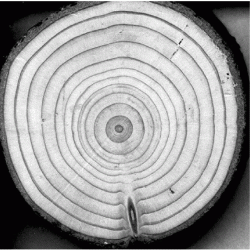Source Institutions
Source Institutions
Add to list Go to activity
Activity link broken? See if it's at the internet archive

In this activity, learners are introduced to tree rings by examining a cross section of a tree, also known as a “tree cookie.” They discover how tree age can be determined by studying the rings and how ring thickness can be used to deduce times of optimal growing conditions. Next they investigate simulated tree rings by applying the scientific method to explore how climatic conditions varied during the Little Ice Age. Use this activity to begin discussions on global warming and climate change. This lesson guide includes background information and handouts. Note: cost of materials does not include cost of purchasing "tree cookies."
- 10 to 30 minutes
- 45 to 60 minutes
- 1 cent - $1 per group of students
- Ages 8 - 18
- Activity, Experiment/Lab Activity, Lesson/Lesson Plan, Simulation
- English
Quick Guide
Materials List (per group of students)
- Overhead projector
- Overhead transparency of tree rings (page 5)
- Copies of simulated tree cores (page 6-7)
- Copies of Student Page
- Tree "cookies" [Contact a local tree trimming service and ask for cuttings or order tree cross-sections from a classroom supply company]
- Magnifying glasses (optional)
- Metric rulers (mm)
- Pencils
Subjects
-
Earth and Space Science
-
Earth Processes
- Weather and Climate
- Earth's History
-
Earth Processes
-
Life Sciences
-
Diversity of Life
- Plants
-
Ecology
- Ecosystems
- Human Impact
-
Diversity of Life
-
Mathematics
-
Data Analysis and Probability
- Data Analysis
- Data Collection
- Data Representation
-
Measurement
- Rate
- Reasoning and Proof
- Representation
-
Data Analysis and Probability
-
The Nature of Technology
-
The Design Process
- Problem Solving
-
The Design Process
-
The Nature of Science
-
The Scientific Process
- Asking Questions
- Conducting Investigations
- Gathering Data
- Formulating Explanations
- Communicating Results
-
The Scientific Process
Informal Categories
- Nature and Environment
Audience
To use this activity, learners need to:
- see
- read
- touch
Learning styles supported:
- Involves teamwork and communication skills
- Involves hands-on or lab activities
Other
Includes alignment to state and/or national standards:
This resource is part of:
Access Rights:
- Free access
By:
Rights:
- All rights reserved, University Corporation for Atmospheric Research, 2005
Funding Sources:
- NCAR Strategic Initiative
- NCAR Opportunity Fund
- NASA
- Friends of UCAR
